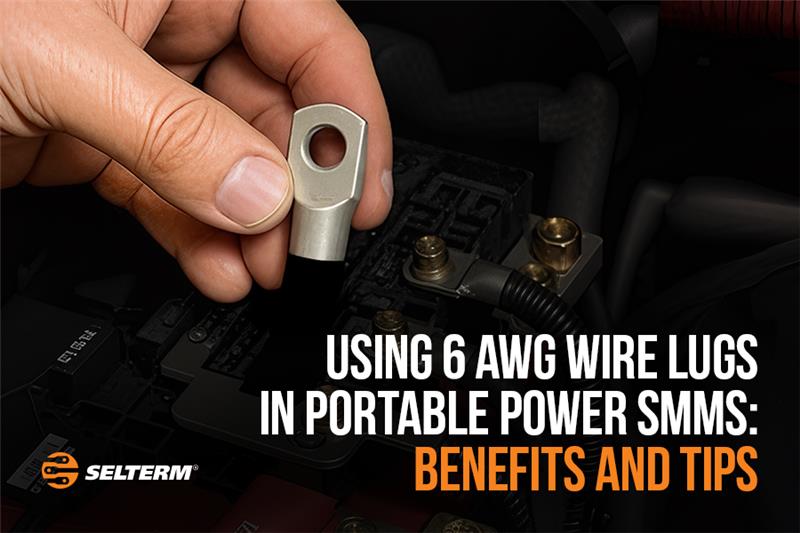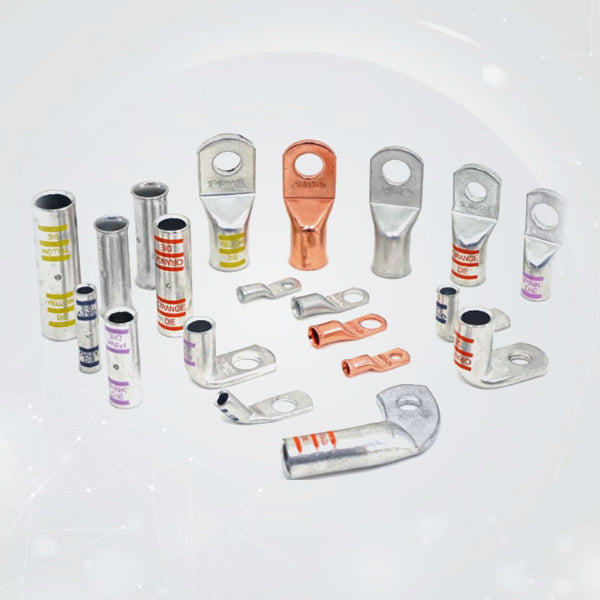
Using 6 AWG Wire Lugs In Portable Power Stations: Benefits And Tips
When constructing or upgrading your portable power station, whether it's for an off-grid camping trip, DIY solar kits, or emergency backup, every connection is important. A single misstep in cabling can lead to voltage drops, heat build-up, or worst of all, equipment failure.
This is the reason that 6 AWG wire lugs, also known as 6 gauge copper battery lugs or 6 gauge AWG battery lugs, have emerged as popular choices in portable power station applications. These medium-duty connectors have a nice compromise between flexibility and power capabilities that make them perfect for portable energy systems where reliability is important but having a low profile is too.
In this blog, we will examine why 6 AWG wire lugs are suitable for use in portable power stations, the advantages of using wire lugs, and some tips to keep in mind when you go to install them.
Why 6 AWG Wire Lugs Are A Great Fit For Portable Power Stations
Portable power stations operate in a sweet middle ground. They need to handle decent amounts of current but must remain compact and easy to transport. That’s exactly where 6 AWG lugs shine.
6 gauge copper battery lugs are designed to support currents in the range of 55 to 65 amps (depending on insulation and temperature conditions), making them ideal for mid-sized batteries, inverters, and charge controllers commonly used in portable setups.
They’re large enough to handle serious power, but not so bulky that they become a hassle to work with in confined enclosures or mobile units. If you’re wiring up a solar generator, a camper battery box, or a backup battery bank for your tools, 6 AWG wire lugs give you the right mix of conductivity and space efficiency.
Key Benefits Of Using 6 AWG Lugs In Power Station Builds
Let’s break down the specific benefits of using 6 gauge AWG battery lugs in your system:
1. Low Electrical Resistance
With their high-conductivity copper body they reduce the resistance of your connections to ensure the best transfer of energy. Less resistance, less heat, this can be a big advantage to make things easier if your power station is enclosed or in a space where heat is hard to manage.
2. Secure, Vibration-Resistant Connections
Portable power stations are frequently in motion, usually found within trailers, RVs, and being portable at job sites. 6 AWG lugs when crimped properly provide stable mechanical connections that will not loosen due to vibration or motion.
3. Corrosion Resistance (With The Right Coating)
If you're using your power station outdoors or in humid conditions, consider looking for tinned copper 6 awg lugs as the tin coating will give you another layer of corrosion resistance and will protect the copper from oxidation, prolonging the life of your connections.
4. Wide Compatibility With Terminals
Whether you’re connecting to a bus bar, inverter terminal, or battery post, 6 gauge lugs are available with various stud sizes (¼”, ⅜”, etc.), giving you flexibility in component selection and layout.
Tips For Working With 6 AWG Wire Lugs
Using the right lugs is only half the battle; the other half is installing them properly. Here are some best practices to keep your connections strong and stable:
Choose The Right Lug For The Job
Make sure the 6 AWG cable lugs you're using match the conductor size and the terminal size you’re connecting to. Oversized or undersized holes will compromise contact quality.
Use A High-Quality Crimping Tool
Handheld crimpers with dies sized specifically for 6 AWG will give you consistent, high-pressure crimps. Avoid generic crimpers that don’t specify wire gauge; they often result in under- or over-crimping.
Double Crimp When Necessary
For longer barrels or high-vibration environments, a double crimp (one at the wire entrance, another near the stud hole) can increase mechanical strength.
Add Heat Shrink For Extra Protection
After crimping, slide a section of adhesive-lined heat shrink tubing over the connection.
This not only provides electrical insulation but also offers strain relief and seals out moisture.
Label Your Cables
It’s easy to lose track of which wire connects where, especially in portable setups. Label your lugs or cables with a heat-shrink marker or wraparound tag to save troubleshooting time later.
What To Avoid When Installing 6 Gauge Copper Battery Lugs
Even seasoned DIYers sometimes make mistakes that affect performance. Keep an eye out for these common issues:
- Not using the appropriate crimping tool: Literally, pliers and crimpers are insufficient. They give you shaky connections that could break when you put a lot of pressure on them.
- Using the wrong type of lug: Don't use aluminum lugs with copper wire! It will create galvanic corrosion. Only use copper lugs with copper wire.
- Torquing the terminal bolt too hard: Tightening too much could dent the lug or create issue with the threads. Use a torque wrench if necessary and follow the specifications of the equipment.
The Final Word
In portable power stations, where space is limited and reliability is non-negotiable, 6 AWG lugs strike the perfect balance. They’re compact, durable, and capable of handling the power demands of most mid-sized systems. Plus, when paired with the right tools and a bit of know-how, they help ensure your system stays safe, efficient, and low-maintenance, even when you’re off the grid.
Check out Selterm’s full range of 6 AWG lugs built for performance, durability, and ease of use, whether you’re wiring up a solar generator, a marine power system, or a custom battery box for your next adventure.

